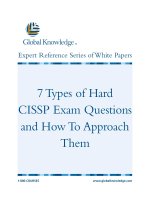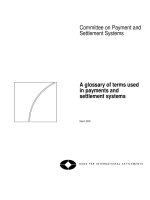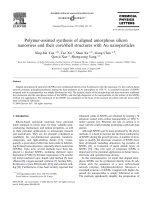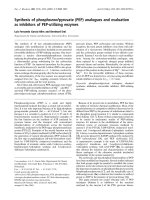synthesis of arithmetic circuits FPGA ASIC and embedded systems
Bạn đang xem bản rút gọn của tài liệu. Xem và tải ngay bản đầy đủ của tài liệu tại đây (7.02 MB, 578 trang )
SYNTHESIS OF
ARITHMETIC CIRCUITS
FPGA, ASIC, and Embedded Systems
JEAN-PIERRE DESCHAMPS
University Rovira i Virgili
GE
´
RY JEAN ANTOINE BIOUL
National University of the Center of the Province of Buenos Aires
GUSTAVO D. SUTTER
University Autonoma of Madrid
A JOHN WILEY & SONS, INC., PUBLICATION
SYNTHESIS OF
ARITHMETIC CIRCUITS
SYNTHESIS OF
ARITHMETIC CIRCUITS
FPGA, ASIC, and Embedded Systems
JEAN-PIERRE DESCHAMPS
University Rovira i Virgili
GE
´
RY JEAN ANTOINE BIOUL
National University of the Center of the Province of Buenos Aires
GUSTAVO D. SUTTER
University Autonoma of Madrid
A JOHN WILEY & SONS, INC., PUBLICATION
Copyright # 2006 by John Wiley & Sons, Inc. All rights reserved.
Published by John Wiley & Sons, Inc., Hoboken, New Jersey. Published simultaneously in Canada.
No part of this publication may be reproduced, stored in a retrieval system, or transmitted in any
form or by any means, electronic, mechanical, photocopying, recording, scanning, or otherwise,
except as permitted under Section 107 or 108 of the 1976 United States Copyright Act, without
either the prior written permission of the Publisher, or authorization through payment of the
appropriate per-copy fee to the Copyright Clearance Center, Inc., 222 Rosewood Drive, Danvers,
MA 01923, 978-750-8400, fax 978-646-8600, or on the web at www.copyright.com. Requests to
the Publisher for permission should be addressed to the Permissions Department, John Wiley & Sons, Inc.,
111 River Street, Hoboken, NJ 07030, (201) 748-6011, fax (201) 748-6008
or online at />Limit of Liability/Disclaimer of Warranty: While the publisher and author have used their best
efforts in preparing this book, they make no representations or warranties with respect to the
accuracy or completeness of the contents of this book and specifically disclaim any implied
warranties of merchantability or fitness for a particular purpose. No warranty may be created or
extended by sales representatives or written sales materials. The advice and strategies contained
herein may not be suitable for your situation. You should consult with a professional where
appropriate. Neither the publisher nor author shall be liable for any loss of profit or any other
commercial damages, including but not limited to special, incidental, consequential, or other damages.
For general information on our other products and services please contact our Customer Care Department
within the U.S. at 877-762-2974, outside the U.S. at 317-572-3993 or fax 317-572-4002.
Wiley also publishes its books in a variety of electronic formats. Some content that appears in print,
however, may not be available in electronic format.
Library of Congress Cataloging-in-Publication Data:
Deschamps, Jean-Pierre, 1945-
Synthesis of arithmetic circuits: FPGA, ASIC and embedded systems/Jean-Pierre Deschamps, Gery
Jean Antoine Bioul, Gustavo D. Sutter.
p. cm.
ISBN-13 978-0471-68783-2 (cloth)
ISBN-10 0-471-68783-9 (cloth)
1. Computer arithmetic and logic units. 2. Digital electronics. 3. Embedded computer systems.
I. Bioul, Gery Jean Antoine. II. Sutter, Gustavo D. III. Title.
TK7895.A65D47 2006
621.39’5 - - dc22 2005003237
Printed in the United States of America
10987654321
To Marc
CONTENTS
Preface xvii
About the Authors xix
1 Introduction 1
1.1 Number Representation, 1
1.2 Algorithms, 2
1.3 Hardware Platforms, 2
1.4 Hardware–Software Partitioning, 3
1.5 Software Generation, 3
1.6 Synthesis, 3
1.7 A First Example, 3
1.7.1 Specification, 3
1.7.2 Number Representation, 6
1.7.3 Algorithms, 6
1.7.4 Hardware Platform, 8
1.7.5 Hardware–Software Partitioning, 8
1.7.6 Program Generation, 9
1.7.7 Synthesis, 10
1.7.8 Prototype, 12
1.8 Bibliography, 14
vii
2 Mathematical Background 15
2.1 Number Theory, 15
2.1.1 Basic Definitions, 15
2.1.2 Euclidean Algorithms, 17
2.1.3 Congruences, 19
2.2 Algebra, 25
2.2.1 Groups, 25
2.2.2 Rings, 27
2.2.3 Fields, 27
2.2.4 Polynomial Rings, 27
2.2.5 Congruences of Polynomial, 32
2.3 Function Approximation, 35
2.4 Bibliography, 36
3 Number Representation 39
3.1 Natural Numbers, 39
3.1.1 Weighted Systems, 39
3.1.2 Residue Number System, 42
3.2 Integers, 42
3.2.1 Sign-Magnitude Representation, 42
3.2.2 Excess-E Representation, 43
3.2.3 B’s Complement Representation, 44
3.2.4 Booth’s Encoding, 47
3.3 Real Numbers, 51
3.4 Bibliography, 54
4 Arithmetic Operations: Addition and Subtraction 55
4.1 Addition of Natural Numbers, 55
4.1.1 Basic Algorithm, 55
4.1.2 Faster Algorithms, 57
4.1.3 Long-Operand Addition, 66
4.1.4 Multioperand Addition, 67
4.1.5 Long-Multioperand Addition, 70
4.2 Subtraction of Natural Numbers, 71
4.3 Integers, 71
4.3.1 B’s Complement Addition, 71
4.3.2 B’s Complement Sign Change, 72
4.3.3 B’s Complement Subtraction, 74
viii
CONTENTS
4.3.4 B’s Complement Overflow Detection, 74
4.3.5 Excess-E Addition and Subtraction, 78
4.3.6 Sign–Magnitude Addition and Subtraction, 79
4.4 Bibliography, 80
5 Arithmetic Operations: Multiplication 81
5.1 Natural Numbers Multiplication, 82
5.1.1 Introduction, 82
5.1.2 Shift and Add Algorithms, 83
5.1.2.1 Shift and Add 1, 83
5.1.2.2 Shift and Add 2, 84
5.1.2.3 Extended Shift and Add Algorithm:
XY þ C þ D,86
5.1.2.4 Cellular Shift and Add, 86
5.1.3 Long-Operand Algorithm, 90
5.2 Integers, 91
5.2.1 B’s Complement Multiplication, 91
5.2.1.1 Mod B
nþm
B’s Complement Multiplication, 92
5.2.1.2 Signed Shift and Add, 93
5.2.1.3 Postcorrection B’s Complement Multiplication, 93
5.2.2 Postcorrection 2’s Complement Multiplication, 96
5.2.3 Booth Multiplication for Binary Numbers, 97
5.2.3.1 Booth-r Algorithms, 97
5.2.3.2 Per Gelosia Signed-Digit Algorithm, 98
5.2.4 Booth Multiplication for Base-B Numbers
(Booth-r Algorithm in Base B), 102
5.3 Squaring, 104
5.3.1 Base-B Squaring, 104
5.3.1.1 Cellular Carry–Save Squaring Algorithm, 104
5.3.2 Base-2 Squaring, 106
5.4 Bibliography, 107
6 Arithmetic Operations: Division 109
6.1 Natural Numbers, 110
6.2 Integers, 117
6.2.1 General Algorithm, 117
6.2.2 Restoring Division Algorithm, 121
6.2.3 Base-2 Nonrestoring Division Algorithm, 121
6.2.4 SRT Radix-2 Division, 126
6.2.5 SRT Radix-2 Division with Stored-Carry Encoding, 131
6.2.6 P–D Diagram, 139
CONTENTS
ix
6.2.7 SRT-4 Division, 142
6.2.8 Base-B Nonrestoring Division Algorithm, 148
6.3 Convergence (Functional Iteration) Algorithms, 155
6.3.1 Introduction, 155
6.3.2 Newton–Raphson Iteration Technique, 155
6.3.3 MacLaurin Expansion—Goldschmidt’s Algorithm, 159
6.4 Bibliography, 161
7 Other Arithmetic Operations 165
7.1 Base Conversion, 165
7.2 Residue Number System Conversion, 173
7.2.1 Introduction, 173
7.2.2 Base-B to RNS Conversion, 173
7.2.3 RNS to Base-B Conversion, 177
7.3 Logarithmic, Exponential, and Trigonometric Functions, 180
7.3.1 Taylor–MacLaurin Series, 181
7.3.2 Polynomial Approximation, 183
7.3.3 Logarithm and Exponential Functions Approximation
by Convergence Methods, 184
7.3.3.1 Logarithm Function Approximation by
Multiplicative Normalization, 184
7.3.3.2 Exponential Function Approximation by
Additive Normalization, 188
7.3.4 Trigonometric Functions—CORDIC Algorithms, 194
7.4 Square Rooting, 198
7.4.1 Digit Recurrence Algorithm—Base-B Integers, 198
7.4.2 Restoring Binary Shift-and-Subtract Square Rooting
Algorithm, 202
7.4.3 Nonrestoring Binary Add-and-Subtract Square Rooting
Algorithm, 204
7.4.4 Convergence Method—Newton –Raphson, 208
7.5 Bibliography, 208
8 Finite Field Operations 211
8.1 Operations in Z
m
, 211
8.1.1 Addition, 212
8.1.2 Subtraction, 213
8.1.3 Multiplication, 213
8.1.3.1 Multiply and Reduce, 214
8.1.3.2 Modified Shift-and-Add Algorithm, 214
x
CONTENTS
8.1.3.3 Montgomery Multiplication, 216
8.1.3.4 Specific Ring, 220
8.1.4 Exponentiation, 221
8.2 Operations in GF(p), 222
8.3 Operations in Z
p
[x]/f(x), 224
8.3.1 Addition and Subtraction, 224
8.3.2 Multiplication, 225
8.4 Operations in GF(p
n
), 228
8.5 Bibliography, 236
Appendix 8.1 Computation of f
ki
, 236
9 Hardware Platforms 239
9.1 Design Methods for Electronic Systems, 239
9.1.1 Basic Blocks of Integrated Systems, 240
9.1.2 Recurring Topics in Electronic Design, 241
9.1.2.1 Design Challenge: Optimizing
Design Metrics, 241
9.1.2.2 Cost in Integrated Circuits, 242
9.1.2.3 Moore’s Law, 243
9.1.2.4 Time-to-Market, 243
9.1.2.5 Performance Metric, 244
9.1.2.6 The Power Dimension, 245
9.2 Instruction Set Processors, 245
9.2.1 Microprocessors, 247
9.2.2 Microcontrollers, 248
9.2.3 Embedded Processors Everywhere, 248
9.2.4 Digital Signal Processors, 249
9.2.5 Application-Specific Instruction Set Processors, 250
9.2.6 Programming Instruction Set Processors, 251
9.3 ASIC Designs, 252
9.3.1 Full-Custom ASIC, 252
9.3.2 Semicustom ASIC, 253
9.3.2.1 Gate-Array ASIC, 253
9.3.2.2 Standard-Cell-Based ASIC, 254
9.3.3 Design Flow in ASIC, 255
9.4 Programmable Logic, 256
9.4.1 Programmable Logic Devices (PLDs), 256
9.4.2 Field Programmable Gate Array (FPGA), 258
9.4.2.1 Why FPGA? A Short Historical Survey, 258
9.4.2.2 Basic FPGA Concepts, 258
CONTENTS
xi
9.4.3 Xilinx
TM
Specifics, 260
9.4.3.1 Configurable Logic Blocks (CLBs), 262
9.4.3.2 Input/Output Blocks (IOBs), 262
9.4.3.3 RAM Blocks, 262
9.4.3.4 Programmable Routing, 264
9.4.3.5 Arithmetic Resources in Xilinx FPGAs, 264
9.4.4 FPGA Generic Design Flow, 264
9.5 Hardware Description Languages (HDLs), 267
9.5.1 Today’s and Tomorrow’s HDLs, 267
9.6 Further Readings, 268
9.7 Bibliography, 268
10 Circuit Synthesis: General Principles 271
10.1 Resources, 272
10.2 Precedence Relation and Scheduling, 277
10.3 Pipeline, 281
10.4 Self-Timed Circuits, 28 2
10.5 Bibliography, 288
11 Adders and Subtractors 289
11.1 Natural Numbers, 289
11.1.1 Basic Adder (Ripple-Carry Adder), 289
11.1.2 Carry-Chain Adder, 292
11.1.3 Carry-Skip Adder, 294
11.1.4 Optimization of Carry-Skip Adders, 298
11.1.5 Base-B
s
Adder, 301
11.1.6 Carry-Select Adder, 303
11.1.7 Optimization of Carry-Select Adders, 307
11.1.8 Carry-Lookahead Adders (CLAs), 310
11.1.9 Prefix Adders, 318
11.1.10 FPGA Implementation of Adders, 322
11.1.10.1 Carry-Chain Adders, 322
11.1.10.2 Carry-Skip Adders, 323
11.1.10.3 Experimental Results, 326
11.1.11 Long-Operand Adders, 327
11.1.12 Multioperand Adders, 328
11.1.12.1 Sequential Multioperand Adders, 328
11.1.12.2 Combinational Multioperand Adders, 330
xii
CONTENTS
11.1.12.3 Carry-Save Adders, 333
11.1.12.4 Parallel Counters, 337
11.1.13 Subtractors and Adder-Subtractors, 344
11.1.14 Termination Detection, 346
11.1.15 FPGA Implementation of the Termination Detection, 348
11.2 Integers, 350
11.2.1 B’s Complement Adders and Subtractors, 350
11.2.2 Excess-E Adders and Subtractors, 352
11.2.3 Sign-Magnitude Adders and Subtractors, 355
11.3 Bibliography, 357
12 Multipliers 359
12.1 Natural Numbers, 360
12.1.1 Basic Multiplier, 360
12.1.2 Sequential Multipliers, 363
12.1.3 Cellular Multiplier Arrays, 363
12.1.3.1 Ripple-Carry Multiplier, 365
12.1.3.2 Carry-Save Multiplier, 368
12.1.3.3 Figures of Merit, 370
12.1.4 Multipliers Based on Dissymmetric
B
r
 B
s
Cells, 370
12.1.5 Multipliers Based on Multioperand Adders, 378
12.1.6 Per Gelosia Multiplication Arrays, 383
12.1.6.1 Introduction, 383
12.1.6.2 Adding Tree for Base-B Partial Products, 384
12.1.7 FPGA Implementation of Multipliers, 386
12.2 Integers, 388
12.2.1 B’s Complement Multipliers, 388
12.2.2 Booth Multipliers, 390
12.2.2.1 Booth-1 Multiplier, 390
12.2.2.2 Booth-2 Multiplier, 392
12.2.2.3 Signed-Digit Multiplier, 397
12.2.3 FPGA Implementation of the Booth-1 Multiplier, 404
12.3 Bibliography, 406
13 Dividers 407
13.1 Natural Numbers, 407
13.2 Integers, 415
13.2.1 Base-2 Nonrestoring Divider, 415
13.2.2 Base-B Nonrestoring Divider, 421
CONTENTS
xiii
13.2.3 SRT Dividers, 424
13.2.3.1 SRT-2 Divider, 424
13.2.3.2 SRT-2 Divider with Carry-Save Computation
of the Remainder, 428
13.2.3.3 FPGA Implementation of the Carry-Save SRT-2
Divider, 434
13.2.4 SRT-4 Divider, 435
13.2.5 Convergence Dividers, 439
13.2.5.1 Newton–Raphson Divider, 439
13.2.5.2 Goldschmidt Divider, 441
13.2.5.3 Comparative Data Between Newton–Raphson
(NR) and Goldschmidt (G) Implementations, 444
13.3 Bibliography, 444
14 Other Arithmetic Operators 447
14.1 Base Conversion, 447
14.1.1 General Base Conversion, 447
14.1.2 BCD to Binary Converter, 449
14.1.2.1 Nonrestoring 2
p
Subtracting Implementation, 449
14.1.2.2 Shift-and-Add BCD to Binary Converter, 450
14.1.3 Binary to BCD Converter, 452
14.1.4 Base-B to RNS Converter, 455
14.1.5 CRT RNS to Base-B Converter, 456
14.1.6 RNS to Mixed-Radix System Converter, 458
14.2 Polynomial Computation Circuits, 463
14.3 Logarithm Operator, 467
14.4 Exponential Operator, 468
14.5 Sine and Cosine Operators, 470
14.6 Square Rooters, 472
14.6.1 Restoring Shift-and-Subtract Square Rooter (Naturals), 472
14.6.2 Nonrestoring Shift-and-Subtract Square Rooter
(Naturals), 475
14.6.3 Newton–Raphson Square Rooter (Naturals), 477
14.7 Bibliography, 479
15 Circuits for Finite Field Operations 481
15.1 Operations in Z
m
, 481
15.1.1 Adders and Subtractors, 481
15.1.2 Multiplication, 484
15.1.2.1 Multiply and Reduce, 484
xiv
CONTENTS
15.1.2.2 Shift and Add, 485
15.1.2.3 Montgomery Multiplication, 487
15.1.2.4 Modulo (B
k
2c) Reduction, 490
15.1.2.5 Exponentiation, 494
15.2 Inversion in GF(p), 497
15.3 Operations in Z
p
[x]/f(x), 500
15.4 Inversion in GF(p
n
), 504
15.5 Bibliography, 510
16 Floating-Point Unit 513
16.1 Floating-Point System Definition, 513
16.2 Arithmetic Operations, 515
16.2.1 Addition of Positive Numbers, 515
16.2.2 Difference of Positive Numbers, 517
16.2.3 Addition and Subtraction, 518
16.2.4 Multiplication, 520
16.2.5 Division, 521
16.2.6 Square Root, 522
16.3 Rounding Schemes, 524
16.4 Guard Digits, 525
16.5 Adder-Subtractor, 527
16.5.1 Alignment, 527
16.5.2 Additions, 529
16.5.3 Normalization, 530
16.5.4 Rounding, 530
16.6 Multiplier, 537
16.7 Divider, 542
16.8 Square Root, 546
16.9 Comments, 548
16.10 Bibliography, 548
Index 549
CONTENTS
xv
PREFACE
From the beginnings of digital electronic science, the synthesis of circuits carrying
out arithmetic operations has been a central topic. As a matter of fact, it is an activity
directly related to computer development. From then on, a well-known technical dis-
cipline was born: computer arithmetic. Traditionally, the study of arithmetic circuits
has been oriented toward applications to general-purpose computers, which provide
the most important applications of digital circuits. However, the electronic market
share corresponding to specific systems (embedded systems) is significant. It is
important to point out that the huge business volume that corresponds to general-
purpose computers (personal computers, servers, main frames) is distributed
among a relatively reduced number of different models. Therefore the number of
designers involved in general-purpose computer development is not as big as it
might seem and is much less than the number of engineers dedicated to production
and sales. The case of embedded systems is different. Embedded systems are circuits
designed for specific applications (special-purpose devices), so a great diversity of
products exist in the market, and the design effort per fabricated unit can be a lot
bigger than in the case of general-purpose computers. In consequence, the design
of specific computers is an activity in which numerous engi neers are involved, in
all type of companies—even small ones—within numerous countries.
In this book methods and examples for synthesis of arithmetic circuits are described
with an emphasis somewhat different from t he classi c tex ts on computer arithmetic.
.
It is not limit ed to the description of the arithmetic units of computers.
.
Descriptions of comp utation algorithms are presented in a section apart from
the one dedicated to their materialization or implementation by digital circuits.
The development of an embedded system is an operation of hardware–software
codesign for which it is not known beforehand what tasks will be executed by a
microprocessor and what other tasks by specific coprocessors. For this reason, it
xvii
appeared useful to describe the algorithms in an independent manner, without
any assumption on subsequent executions by an existent processor (software) or
by a new customized circuit (hardware).
.
A special, although not exclusive, importance has been given to user program-
mable devices (field programmable devices such as FPGAs), especially to the
families Spartan II and Virtex. Those devices are very commonly used for the
realization of specific systems, mainly in the case of small series and proto-
types. The particular architecture of those components leads the designer to
use synthesis techniques somewhat different from the ones applied for ASICs
(application-specific integrated circuits) for which standard cell libraries exist.
.
In what concern circuits description, logic schemes are presented, sometimes
with some VHDL models, in such a way that the corresponding circuits can
easily be simulated and synthesized.
After an introductory chapter, the book is divided in two parts. The first one is
dedicated to mathematical aspects and algorithms: mathematical background
(Chapter 2), number representation (Chapter 3), addition and subtraction (C hapter
4), multiplication (Chapter 5), division (Chapter 6), other arithmetic operations
(Chapter 7), and operations in finite fields (Chapter 8). The second part is dedicated
to the central topic—the synthesis of arithmetic circuits: hardware platforms
(Chapter 9), general principles of synthesis (Chapter 10), adders and subtractors
(Chapter 11), multipliers (Chapter 12), dividers (Chapter 13), other arithmetic primi-
tives (Chapter 14), operators for finite fields (Chapter 15), and floating-point unit.
Numerous VHDL models, and other source files, can be downloaded from http://
www.ii.uam.es/ gsutter/arithmetic/. This will be indicated in the text (e.g., com-
plete VHDL source code available). As regards the VHDL models, they are of two
types: some of them have been developed for simulation purposes only, so the work-
ing of the corresponding circuit can be observed; others are synthesizable models that
have been implemented within commercial programmable components (FPGA’s).
The authors thank the people who have helped them in developing this book,
especially Dr. Tim Bratten, for correcting the text, and Paula Miro
´
n, for the cover
design. They are grateful to the following universities for providing them the
means for carrying this work through to a successful conclusion: University
Rovira i Virgili (Tarragona, Spain), University Rey Juan Carlos (Madrid, Spain),
State University UNCPBA (Tandil, Argentina), Uni versity FASTA (Mar del
Plata, Argentina), and Autonomous University of Madrid (Spain).
J
EAN-PIERRE DESCHAMPS
University Rovira i Virgili
G
E
´
RY JEAN ANTOINE BIOUL
National University of the Center of the Province of Buenos Aires
G
USTAVO D. SUTTER
University Autonoma of Madrid
xviii PREFACE
ABOUT THE AUTHORS
Jean-Pierre Deschamps received a MS degree in electrical engineering from the
University of Louvain, Belgium, in 1967, a PhD in computer science from the
Autonomous University of Barcelona, Spain, in 1982, and a PhD degree in electrical
engineering from the Polytechnic School of Lausanne, Switzerland, in 1983. He has
worked in several companies and universities. He is currently a professor at the
University Rovira i Virgili, Tarragona, Spain. His research interests include ASIC
and FPGA design, digital arithmetic, and cryptography. He is the author of six
books and about a hundred international papers.
Ge
´
ry Jean Antoine Bioul received a MS degree in physical aerospace engineering
from the University of Lie
`
ge, Belgium. He worked in digital systems design with
PHILIPS Belgium and in computer-aided industrial logistics with several For-
tune-100 U.S. companies in the United States, and Africa. He has been a professor
of compute r architecture in several universities mainly in Africa and South America.
He is currently a professor at the State University UNCPBA of Tandil (Buenos
Aires), Argentina, and a professor consultant at the Saint Thomas University
FASTA of Mar del Plata (Buenos Aires), Argentina. His research interests include
logic design and computer arithmetic algorithms and implementations. He is the
author of about 50 international papers and patents on fast arithmetic units.
Gustavo D. Sutter received a MS degree in Computer Science from the State
University UNCPBA of Tandil (Buenos Aires), Argentina, and a PhD degree
from the Autonomous University of Madrid, Spain. He has been a professor at
the UNCPBA, Argentina and is currently a professor at the University Autonoma
of Madrid, Spain. His research interests include ASIC and FPGA design, digital
arithmetic, and development of embedded systems. He is the author of about 30
international papers and communications.
xix
1
INTRODUCTION
The design of embedded systems, that is, circuits designed for specific applications,
is based on a series of decisions as well as on the use of several types of development
techniques. For example:
.
Selection of the data repr esentation
.
Generation or selection of algorithms
.
Selection of hardware platforms
.
Hardware–software partitioning
.
Program generation
.
New hardware synthesis
.
Cosimulation, coemulation, and prototyping
Some of these activities have a close relationship with the study of arithmetic
algorithms and circuits, especially in the case of systems including a great
amount of data processing (e.g., ciphering and deciphering, image processing,
digital signature, biometry).
1.1 NUMBER REPRESENTATION
When using general-purpose equipment, the designer has few possible choices
concerning the internal representation of data. He must conform to some fixed
1
Synthesis of Arithmetic Circuits: FPGA, ASIC, and Embedded Systems
By Jean-Pierre Deschamps, Ge
´
ry J. A. Bioul, and Gustavo D. Sutter
Copyright # 2006 John Wiley & Sons, Inc.
and predefined data types such as integer, floating-point, double precision, and char-
acter. On the contrary, if a specific system is under development, the designer can
choose, for each data, the most convenient type of representation. It is no longer
necessary to choose some standard fixed-point or floating-point numeration
system. Nonstandard specific formats can be used. In Chapter 3 the main number
representation methods will be defined.
1.2 ALGORITHMS
Every complex data processing operation must be decomposed into simpler
operations — the computation primitives — executable either by the main pro-
cessor or by some specific coprocessor. The way the com putation primitives are
used in order to perform the complex operation is what is meant by algorithm.
Obviously, knowledge of algorithms is of fundamental importance for developing
arithmetic procedures (sof tware) and circuits (hardware). It is the topic of
Chapters 4–8.
1.3 HARDWARE PLATFORMS
The selection of a hardware platform is based on the answer to the following ques-
tion. How do we get the desired behavior at the lowest cost, while fulfilling som e
additional constraints? As a matter of fact, the concept of cost must be carefully
defined in each particular case. It can cover several aspects: for example, the unit
production cost, the nonrecurring engi neering costs, and the implicit cost for a
late introduction of the product to the market. Some examples of additional technical
constraints are the size of the system, its power consumption, and its reliability and
maintainability.
For systems requiring little data processing capability, microcontrollers and low-
range microprocessors can be the best choice. If the computation needs are greater,
more powerful microprocessors, or even digital signal processors (DSPs), should be
considered. This type of solution (microprocessors and DSPs) is very flexible as the
development work mainly consists in generating programs.
For getting higher performances, it may be necessary to develop specific circuits.
A first option is to use a programmable device, for example, a field-programmable
gate array (FPGA). It could be an interesting option for prototypes and small series.
For greater series, an application-specific integrated circuit (ASIC) should be
developed. ASIC vendors offer several types of products: for example, gate
arrays, with relatively small prototyping costs, or standard cell libraries, integrating
a complete system-on-chip (SOC) including processors, program memories, data
memories, logic, macrocells, and analog interfaces.
A brief presentation of the most common hardware platforms is given in
Chapter 9.
2 INTRODUCTION
1.4 HARDWARE –SOFTWARE PARTITIONING
The hardware –software partitioning consists of deciding which operations will be
executed by the central processing unit (the software) and which ones by specific
coprocessors (the hardware). As a matter of fact, the platform selection and the
hardware –software partitioning are tightly related operations. For systems requiring
little data processing capability, the whole system is implemented in software. If
higher performances are necessary, the noncritical operations, as well as control
of the operation sequence, are executed by the central processing unit, while the
critical ones are implemented within specific coprocessors.
1.5 SOFTWARE GENERATION
The operations belonging to the software block of the chosen partition must be pro-
grammed. In Chapters 4–8 the algorithms are presented in an Ada-like language that
can easily be translated to C or even to the assembly language of the chosen
microprocessor.
1.6 SYNTHESIS
Once the hardware– software partition has been defined, all the tasks assigned to the
specific hardware (FPGA, ASIC) must be transl ated into circuit descriptions. Some
important synthesis principles and methods are described in Chapter 10. The syn-
thesis of arithmetic circuits, based on the algorithms of Chapters 4 –8, is the topic
of Chapters 11–15, and an additional chapter (16) is dedicated to the implemen-
tation of floating-point arithmetic.
1.7 A FIRST EXAMPLE
Common examples of application fields reso rting to embedded solutions are crypto-
graphy, access control, smart cards, automotive, avionics, space, entertainment, and
electronic sales outlets. In order to illustrate the main steps of the design process, a
small digital signature system will now be developed (complete assembly language
and VHDL code available).
1.7.1 Specification
The system under development (Figure 1.1) has three inputs,
.
character is an 8-bit vector.
.
new_character is a signal used for synchronizing the input of successive
characters.
.
sign is a control signal ordering the computation of a digital signature.
1.7 A FIRST EXAMPLE 3









